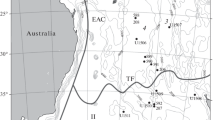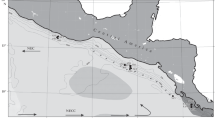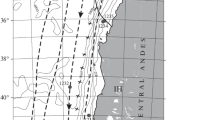Abstract—Lithological–facies zonality of Neo– and Eopleistocene sediments from the Fiji Sea is described for the first time. Processing of corresponding maps and isopachite schemes using A.B. Ronov’s volumetric method gave us an opportunity to calculate the quantitative parameters of sedimentation for distinguished types of Pleistocene sediments. Carbonate sediments dominate over other groups of sediments. Carbonate planktonic sediments have been more intensively accumulated in the Neopleistocene than in the Eopleistocene. The highest volcanotectonic activity is typical of Eopleistocene.
Similar content being viewed by others
Avoid common mistakes on your manuscript.
INTRODUCTION
This brief communication continues a cycle of our works on the Pleistocene sediments from submarine margins of the World Ocean (Levitan et al., 2018). This cycle considers separately the Neopleistocene, i.e., Middle and Late Pleistocene (Q2+3, 0.01–0.80 Ma), and the Eopleistocene or Early Pleistocene (Q1, 0.80–1.80 Ma according to the old scale (Gradstein et al., 2004). Conclusions made in cited publications on the back–arc sedimentary basins on the active margins of the northern and western Pacific Ocean are mainly based on the results of deep–sea drilling. In this communication, however, we shall describe the evolution of the Pleistocene sediments of two interarc basins located in the Fiji Sea.
MODERN SEDIMENTATION CONDITIONS
The Fiji Sea in the north is bounded by the Fiji and New Caledonia islands and the New Hebrides Trench. Its eastern boundary is the double Tonga island–arc–Kermadec trench system. In the west and south, the considered region is bounded by the Norfolk submarine ridge and Northern New Zealand, respectively (Fig. 1). The average water depth is 2740 m, and the maximum depth (southeast of New Caledonia Island) is 7633 m (Zalogin and Kosarev, 1999).
Location of deep–water holes in the Fiji Sea. Symbols: (1) deep–sea drilling holes, (2) surface currents, (3) isobaths. Numbers in the map: (1) South Fiji Basin, (2) New Hebrides deep–water trench; (3) Lau–Colville Ridge; (4) Lau Basin; (5) Norfolk Ridge; (6) Tonga Ridge; (7) Caledonian Basin. Surface currents (Ganachaud et al., 2007): NVJ-North Vanuatu Jet; SVJ—South Vanuatu Jet; SCC—Subtropical Counter Current; EAC—East Auckland Current. Isobaths are given in m (www.gebco.org).
The considered region comprises two inter–arc sedimentary basins: Lau and South Fiji. The Lau Basin is located between the Tonga–Kermadec Ridge in the east and the Lau–Colville ridge in the west. The crest surface of the Tonga–Kermadec ridge is located at a depth about 1000 m, while the surface of the Lau–Colville Ridge, at about 2000 m. The Lau Basin began to form during spreading approximately 5–6 Ma ago. It is represented by alternation of NE–trending narrow linear depressions and ridges, which reflect the oceanic basement topography. The average relative altitudes are 300–400 m (about 2300 m deep above the ridges and 2600–2700 m above the depressions) (Parson et al., 1992). In the Pleistocene and modern epoch, the Lau Basin is characterized by the active hydrothermal activity expressed in the formation of metalliferous sediments and deep–water sulfides (Bogdanov et al., 2006).
The South Fiji Basin with depths over 4000 m is located between the Lau–Colville Ridge in the east and the Norfolk Ridge in the west. The Norfolk Ridge (average depth of 2500 m) in many areas is crowned by guyots with summit depths about 1200–1600 m (www.gebco.com). Coral buildups are widespread in the northern shallow part of the Fiji Sea. The South Fiji Basin floor has numerous submarine volcanoes, which also reveal activity at modern epoch (Zalogin and Kosarev, 1999). The sediments of the surface layer are dominated by planktonic carbonate oozes (McCoy et al., 2003). Two deepest areas of the South Fiji Basin slightly below the carbonate compensation depth (CCD) are filled with tuffite zeolite pelagic clays. They are rimmed by narrow bands of carbonate clays (15–30% СаСО3).
The Fiji Sea is situated in the tropical climatic belt. The annual temperatures on the sea surface are higher than 20°С, varying from 18–23°С in the southeast to 25–28°С in the north of the basin (Zalogin and Kosarev, 1999). The basin is characterized by the tides from 1.5 to 3.0 m high and frequent tropical storms.
The considered basins are parts of a global subtropical circulation. Its northern part comprises the west–directed North and South Vanuatu jets of the South Equatorial Current, while the southern part contains east–directed East Auckland Current and Subtropical Counter Current (Ganachaud et al., 2007) (Fig. 1). Within the considered region, the pure primary production decreases from the south northward from 600–800 mg C/m2/yr north of New Zealand to 300–500 mg C/m2/yr at the Fiji Island latitude. Biologically, the pure production is referred to as the difference between the bulk primary production and its portion consumed as feed.
FACTUAL MATERIAL AND METHODS
Four deep–sea drilling cruises have been carried out in the considered area: DSDP Cruise 21 (Burns et al., 1973) and Cruise 30 (Andrews et al., 1975), ODP Cruise 135 (Parson et al., 1992), and IODP Cruise 330 (Expedition…, 2011). The location of drilled holes is shown in Fig. 1. Lithological, stratigraphic, and physical data on the Pleistocene deposits were taken from cited reports on deep–sea drilling. It should be noted that no data were obtained for the stratigraphic subdivision of the Pleistocene pelagic clays and foraminiferal sediments of the Norfolk Ridge, where mainly guyots (Ridjil and Ashernar, and others) were drilled. Therefore, the estimated thickness of the Neo– and Eopleistocene sediments in these holes is approximate. Isobaths shown in Fig. 1 are based on the General bathymetric map of the World Ocean (www.gebco.org) issued in 2004.
The comparative lithological analysis was carried out using a lithological map of the modern sediments of the Pacific Ocean (McCoy et al., 2003). Based on our study of the Pleistocene of Australian seas (Levitan et al., 2019), it was conditionally accepted that the boundary between foraminiferal sediments and nannoooze lies along the isobaths of 2500 m.
RESULTS
Drilling data were used to compile the lithological–facies schemes (with isopachs) for two age sections: Neopleistocene and Eopleistocene (Figs. 2, 3). The schemes were constructed using a transverse equal–area azimuthal projection on a scale 1 : 10 000 000.
Lithological–facies map of the Neopleistocene sediments. Symbols: (1) tuffite zeolite pelagic clays; (2) foraminiferal sediments; (3) clayey foraminiferal muds; (4) nano (coccolithic) ooze; (5) clayey nannoooze; (6) alternation of clayey nannoooze and foraminiferal turbidites; (7) alternation of clayey nannoooze and clayey conglomerates; (8) alternation of volcanogenic clays and volcanogenic turbidites; (9) alternation of clayey nannoooze and volcanogenic turbidites; (10) alternation of volcanogenic silts and sands with volcanogenic turbidites; (11) vitric ash; (12) alternation of nannoooze and tephra; (13) erosion area; (14) isopachs (in m); (15) deep–sea drilling hole.
Lithological–facies map of Eopleistocene sediments. Symbols are shown in Fig. 2.
In general, the Neopleistocene lithological–facies map (Fig. 2) for the South Fiji sedimentary basin is practically identical to the maps of modern sediments, showing the predominance of nannoooze (coccolithic ooze) and foraminiferal sediments (including foraminiferal sands on the tops of the guyots of the Norfolk Ridge). The clay nannoooze in the South Fiji Basin is located slightly above the ССD, while tuffite pelagic clays with volcanic glasses (partially zeolitized) and vitric ash intercalations are located below this surface. The thickness of the pelagic clays is no more than 6 m. To the north, the thickness of the Neopleistocene sediments increases, reaching more than 25 m on the northern termination of the South Fiji Basin.
The Neopleistocene deposits of the Lau sedimentary basin show much higher facies diversity. Clayey nannoooze accumulated on the submarine ridges contains up to 5–10% volcanic glass, while submarine depressions are filled with vitric–rich clay nannoooze (up to 75% СаСО3) alternating with diverse sediments: foraminiferal turbidites (hole 834, most close to the Fiji Archipelago); clay conglomerates (hole 835); and volcanogenic turbidites (hole 836). In the Tonga Ridge, the Neopleistocene sediments are represented by nannoooze alternating with volcanogenic clays, silts, and sands. The predominant part of volcaniclastics in the Lau Basin is likely made up of the explosion products of the Tonga Ridge (Parson et al., 1992). The thickness of Neopleistocene sediments in the Lau sedimentary basin varies between 25 and 50 m, rarely exceeding this value.
The distribution area of the Neopleistocene sediments in the Fiji Sea is 2865.2 thou km2 (Table 1). The sediments are mainly represented by nannoooze and foraminiferal ooze (1163.9 and 927.5 thou km2, respectively). A smaller area is occupied by the clay nannoooze (266.5 thou km2), clayey foraminiferal ooze (199.2 thou km2), and pelagic clays (74.2 thou km2). The remaining area is covered by alternating sediments of different composition.
The volume of Neopleistocene sediments in the Fiji Sea is 31.9 thou km3 (Table 1). The volumetric proportions of sediments of different composition are as follows: nannoooze (35.4%), clayey nannoooze (21.6%), foraminiferal sediments (20.4%), clayey foraminiferal ooze (14.1%), clayey conglomerates (4.1%), volcanogenic clays, silts, and sands (2.5%), pelagic clays (1.6%), volcanogenic turbidites (0.3%), and foraminiferal turbidites (less than 0.1%).
The Eopleistocene lithological–facies map (Fig. 3) of the South Fiji sedimentary basin is identical to the Neopleistocene map (including thicknesses), whereas the Eopleistocene sediments of the Lau sedimentary basin significantly differ from Neopleistocene sediments. First of all, the Neopleistocene sediments are absent at the Tonga Ridge (hole 840) and in hole 836. Hole 203 recovered alternation of vitric ash with nannoooze in proportions of 75/25. Hole 838 in the considered part of the section recovered the alternation of volcanogenic silty clays with volcanogenic sandy turbidites in proportions of 30/70. The thickness of the Eopleistocene sediments usually exceeds that of Neopleistocene sediments in the same holes and locally exceeds (hole 203) 100 m.
The distribution area of the Eopleistocene sediments in the Fiji Sea is 2698.7 thou km2 (Table 1). They are dominated by foraminiferal ooze and nannoooze (1045.5 and 1023.7 thou km2, respectively). The smaller area is occupied by clayey nannoooze (201.5 thou km2), clayey foraminiferal ooze (189.6 thou km2), and pelagic clays (64.5 thou km2). The remaining area is occupied by sequences of alternating sediments of different composition.
The volume of Eopleistocene sediments in the Fiji Sea is 35.1 thou км3 (Table 1), including foramineral sediments (26.8%), nannoooze (24.5%), clayey nannoooze (16.5%), clayey foramineral ooze (11.7%), volcanogenic turbidites (6.7%), volcanogenic clays and silts (1.3%), pelagic clays (1.1%), and foraminiferal turbidites (0.23%).
The recalculation of volumes of sediments of different type for masses of dry sediment and, further, for masses of sediment per time unit allowed us to obtain interesting data on the evolution of the quantitative parameters of sedimentation in the studied part of the Pleistocene (Table 2). In particular, there is an obvious weak increase of the accumulation rate of carbonate sediments in the Neopleistocene as compared to the Eopleistocene (IQ2–3/IQ1 = 1.18). This trend coincided with that of the Australian seas (Levitan et al., 2019), but is weaker expressed owing to the larger distance from the areas of elevated primary production near continents. In our calculations, we ignored foraminiferal turbidites, because, as was shown previously, this type of sediments rather characterizes slope processes than carbonate accumulation (Levitan and Gelvi, 2016).
At the same time, the volcanotectonic activity was higher in the Eopleistocene (IQ2–3/IQ1 = 0.56). The main contribution was provided by volcanogenic turbidites, which were supplied from the basement uplift slopes in the Lau Basin, the Tonga Ridge, and vitric ashes from different sources. It should be noted that the Tonga Ridge in the Eopleistocene served as an area of active effusive magmatism. The indicated magmatic and tectonic activity in the studied region, especially, in the Lau sedimentary basin, was related to the acceleration of the Pacific subduction beneath the Tonga–Kermadec arc system.
CONCLUSIONS
This brief communication report data on two back–arc sedimentary basins in the Fiji Sea: Lau and South Fiji. Processing of compiled lithological–facies maps using A.V. Ronov volumetric method (1949) allowed some conclusions to be drawn concerning the evolution of facies structure and quantitative parameters of sediments during Eo- and Neopleistocene.
Both basins are characterized by significant role of volcanic ash and abundant admixture of volcanic glass in the sedimentary cover. The volcanotectonic processes in the Lau Basin were sufficiently active in the Eopleistocene, whereas the “background” pelagic planktonogenic carbonate accumulation was intensified in the Neopleistocene. In our opinion, the relatively large magmatic and tectonic activity in the Lau sedimentary basin as compared to the South Fiji sedimentary basin is related to the younger age of the oceanic basement in the Lau basin and its more proximal position to the subduction zone.
REFERENCES
J. E. Andrews, G. Packham, et al., Initial Reports of the Deep Sea Drilling Project 30, (1975).https://doi.org/10.2973/dsdp.proc.30.1975
Yu. A. Bogdanov, A. P. Lisitsyn, A. M. Sagalevich, and E. G. Gurvich, Seafloor Hydroythermal Ore Genesis (Nauka, Moscow, 2006) [in Russian].
R. E. Burns, J. E. Andrews, et al., Initial Reports of the Deep Sea Drilling Project 21, (1973).https://doi.org/10.2973/dsdp.proc.21.103.1973
“Expedition 330 Scientists Loisville Seamount Trail: implications for geodynamic mantle flow models and the geochemical evolution of primary hotspots,” IODP Prel. Rept. 330, (2011). https://doi.org/10.2204/iodp.pr.330.2011
A. Ganachaud, et al., “Southwest Pacific circulation and climate experiment (SPICE). Part I,” CLIVAR Publ. Series 111, (2007).
F. M. Gradstein, J. G. Ogg, A. G. Smith, et al., A Geologic Time Scale 2004 (Cambridge Univ. Press, 2004).https://doi.org/10.4095/215638
M. A. Levitan and T. N. Gelvi, “Quantitative parameters of Pleistocene pelagic sedimentation in the Atlantic Ocean,” Geochem. Int. 54 (12), 1049–1060 (2016).https://doi.org/10.1134/S0016702916120089
M. A. Levitan, T. A. Antonova, and A. V. Koltsova, “Facies structure and quantitative parameters of Pleistocene sediments form the East Australian continental margin,” Geochem. Int. 57 (6), 698–708 (2019).https://doi.org/10.1134/S0016702919060053
M. A. Levitan, T. N. Gelvi, K. V. Syromyatnikov, and K. D. Chekan, “Facies structure and quantitative parameters of Pleistocene sediments of the Bering Sea,” Geochem. Int. 56 (4), 304–317 (2018).https://doi.org/10.1134/S0016702918040055
F. H. McCoy, T. R. Suint, and D. Z. Piper, “Types of bottom sediments,” International Geological–Geophysical Atlas of the Pacific Ocean, Ed. by G. B. Udintsev (Moscow–St. Petersburg, 2003), pp. 114–115. [in Russian].
L. Parson, J. Hawkins, J. Allan, et al., Proc. Ocean Drilling Program 135, (1992).
A. B. Ronov, History of Sedimentation and Fluctuations in the European USSR: Volumetric Data (Geofiz. Inst. AN SSSR, Moscow, 1949) [in Russian].
www.gebco.org
B. S. Zalogin and A. N. Kosarev, Seas (Mysl’, Moscow, 1999) [in Russian].
ACKNOWLEDGMENTS
This paper was partially supported by the Russian Foundation for Basic Research (no. 17-05-00157) and the Program of Presidium of the Russian Academy of Sciences (project 49P). This work was made in the framework of the State Task (project no. 0137-2016-0008).
Author information
Authors and Affiliations
Corresponding author
Additional information
Translated by M. Bogina
Rights and permissions
About this article
Cite this article
Levitan, M.A., Antonova, T.A. & Koltsova, A.V. Facies Structure and Quantitative Parameters of the Pleistocene Sediments of the Fiji Sea. Geochem. Int. 57, 1230–1235 (2019). https://doi.org/10.1134/S0016702919110053
Received:
Revised:
Accepted:
Published:
Issue Date:
DOI: https://doi.org/10.1134/S0016702919110053







